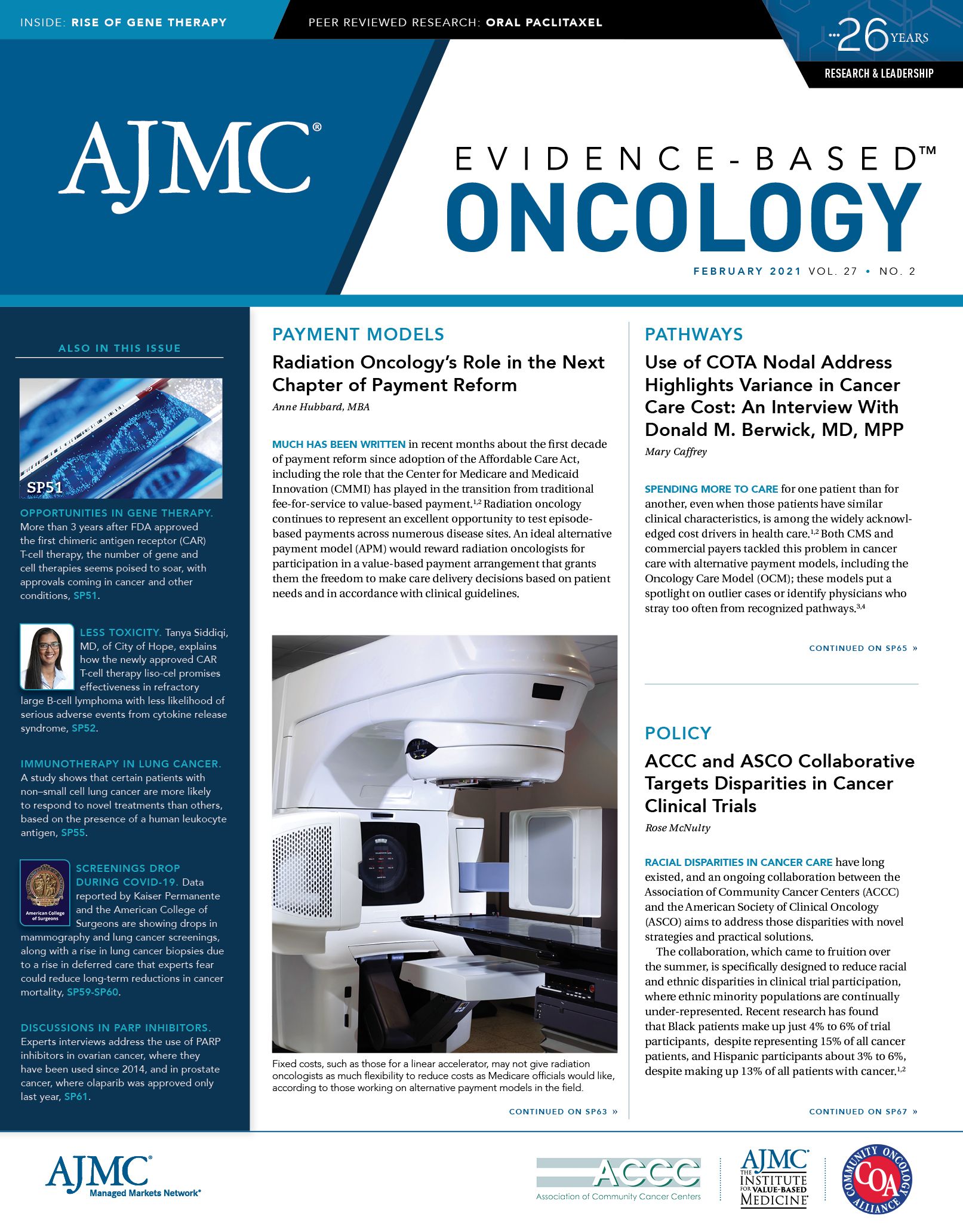- Center on Health Equity & Access
- Clinical
- Health Care Cost
- Health Care Delivery
- Insurance
- Policy
- Technology
- Value-Based Care
Azacitidine Is Shown to Improve Overall, Relapse-Free Survival in Older Adults With AML
Older adults with acute myeloid leukemia (AML) saw increased overall and relapse-free survival, as well as preserved quality of life, following oral administration of 300-mg azacitidine.
Older adults with acute myeloid leukemia (AML) saw increased overall survival (OS) and relapse-free survival (RFS), as well as preserved quality of life (QOL), following oral administration of azacitidine as maintenance therapy, according to study data published in The New England Journal of Medicine.1
The formulation of azacitidine used in the phase 3, randomized, double-blind, placebo-controlled QUAZAR AML-001 study was CC-486 (Onureg; Bristol Myers Squibb [BMS]), “a hypomethylating agent that is not bioequivalent to injectable azacitidine,” the authors noted. As a result, CC-486 is not interchangeable with the intravenous and subcutaneous forms of azacitidine, BMS officials said in a statement announcing the FDA approval in September.2
In the study, with its primary end point of OS and secondary end points of RFS and health-related QOL, a 300-mg dose of CC-486 was administered each day for 14 days of a 28-day cycle. The 472 participants were randomized 1:1 to receive CC-486 (n = 238) or placebo (n = 234) between May 2013 and October 2017, and the data cutoff point was July 15, 2019. CC-486 was given for a median of 12 (range, 1-80) cycles and placebo, 6 (range, 1-73) cycles.
Results show significant improvement in both OS and RFS with the use of CC-486. There was a 40% increase of OS compared with placebo; the CC-486 and placebo groups saw a median OS from randomization of 24.7 vs 14.8 months (P < .0001), respectively. For RFS, there was a 53% difference: 10.2 vs 4.8 months (P < .0001). Median follow-up was 41.2 months.
The trial was conducted as 148 sites in 23 countries. The median patient age was 68 (range, 55-86) years. Eligibility criteria included the following:
- Being 55 years or older
- Having newly diagnosed de novo AML (91%) or secondary AML and intermediate- or poor-risk cytogenetic characteristics (86%) at diagnosis
- Not being eligible for hematopoietic stem-cell transplantation
- Being in complete remission with/without complete blood count recovery
- Having a screening Eastern Cooperative Oncology Group score of 0 to 3
Before trial enrollment, all patients also received induction, while 78% of the CC-486 group and 82% of the placebo group received at least 1 course of consolidation chemotherapy. The median time from induction therapy to randomization was 4.0 months; for complete remission to randomization it was 85.0 days.
Additional findings show an ongoing survival advantage with CC-486 vs placebo at the 1- and 2-year marks for OS. At 1 year, approximately 72.8% and 55.8% (difference, 17 percentage points; 95% CI, 8.4-25.6), respectively, were alive, whereas at 2 years, 50.6% and 37.1% (difference, 13.5 percentage points; 95% CI, 4.5-22.5) were.
“An overall survival benefit was observed with CC-486 regardless of whether patients had received any consolidation therapy, had been in complete remission after induction chemotherapy, or had had persistent measurable residual disease at randomization,” the authors noted.
Meanwhile, for RFS at 6 months and 1 year, the CC-486 and placebo groups came in at 67.4% and 45.2% (difference, 22.2 percentage points; 95% CI, 13.2-31.2) and 44.9% and 27.4% (difference, 17.5 percentage points; 95% CI, 8.5-26.4), respectively.
For health-related QOL, no clinically meaningful differences were seen via least squares mean changes from baseline at any visit.
Dosing interruptions were seen in 43% of the CC-486 and 17% of the placebo groups; dose reductions in 16% and 3%, respectively; and discontinuation, 13% and 4%.
The most common adverse events in both groups were grade 1/2 gastrointestinal events (eg, nausea, vomiting, diarrhea) and grade 3/4 thrombocytopenia and neutropenia.
Possible future areas of study are the molecular characteristics that predispose patients with AML to better outcomes following maintenance therapy and if CC-486 confers a survival advantage in other clinical contexts.
References
1. Wei AH, Döhner H, Pocock C, et al. Oral azacitidine maintenance therapy for acute myeloid leukemia in first remission. N Engl J Med. 2020;383(26):2526-2537. doi:10.1056/NEJMoa2004444
2. US Food and Drug Administration approves Onureg (azacitidine tablets), a new oral therapy, as continued treatment for adults in first remission with acute myeloid leukemia. News release. BusinessWire. September 1, 2020. Accessed January 7, 2021. https://www.businesswire.com/news/home/20200901005914/en/U.S.-Foodand-Drug-Administration-Approves-Onureg%C2%AE-azacitidine-tablets-a-New-Oral-Therapy-as-Continued-Treatment-for-Adults-in-First-Remission-with-Acute-Myeloid-Leukemia

